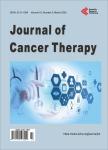The Prognostic Value of Minimally Involved Melanoma Sentinel Lymph Nodes
The Prognostic Value of Minimally Involved Melanoma Sentinel Lymph Nodes作者机构:Department of Visceral Surgery Centre Hospitalier Universitaire Vaudois Lausanne Switzerland University Institute of Pathology Centre Hospitalier Universitaire Vaudois Lausanne Switzerland
出 版 物:《Journal of Cancer Therapy》 (癌症治疗(英文))
年 卷 期:2013年第4卷第10期
页 面:1490-1498页
学科分类:1002[医学-临床医学] 100214[医学-肿瘤学] 10[医学]
主 题:Metastatic Melanoma Sentinel Node Minimally Involved
摘 要:Background: Sentinel node (SLN) status is the most important prognostic factor for early-stage melanoma patients. It will influence follow-up and may change therapy. Positive SLNs present different degrees of involvement so that subgroups of patients may have minimal SLN invasion. The aim of this study was to evaluate survival in subgroups with minimally involved SLNs and to compare them to negative SLN patients. Method: SLN biopsy was performed in 499 consecutive clinically N0 patients between 1997 and 2008. Following updated recommendations from the Melanoma Group of the European Organization of Research and Treatment of Cancer, degrees of SLN involvement were fully reassessed for two anatomopathological parameters: tumour burden according to Rotterdam criteria (1.0 mm) and microanatomic location according to Dewar (subcapsular, combined subcapsular and parenchymal, parenchymal, multifocal, or extensive). Minimally involved SLNs were defined as those with tumor burden 0.1 mm and/or subcapsular metastasis location. Kaplan-Meier and multivariable logistic regression analyses were performed. Results: Out of 499 clinically N0 patients, positive SLNs were found in 123 patients (24.7 percent). With a median follow-up of 52 months (range: 9 - 146), five-year disease-free (DFS), disease-specific survival (DSS) and overall survival (OS) were 88.1, 93.9 and 89.9 percent for negative SLN patients, respectively. In minimally involved SLNs, there were 21 with tumour burden 0.1 mm, and 52 with subcapsular metastasis. Five-year DFS, DSS and OS in these sub-groups were 79.6, 86.6 and 86.6 percent, then 57.3, 69.8 and 67.8 percent respectively. DFS univariable analysis of these sub-groups compared to negative SLNs showed: (HR1.89, 95 percent CI 0.75 - 4.79;p 0.175) and (HR 3.92, 95 percent CI 2.29 - 6.71;p 0.0001) respectively. Minimally involved sub-groups were not predictive for NSLN negativity. Conclusion: Rotterdam’s tumour burden stratification is an easy and useful progn



